Seismic load refers to the force or shock experienced by a structure during an earthquake. This occurs at the interfaces between the structure and the ground or with neighboring structures. These loads are crucial in the design and analysis of buildings, bridges and other structures located in seismically active regions. They can act in any direction, so the greatest focus in seismic design is on longitudinal and lateral forces. From the point of view of their impact on a given building, they are unpredictable not only in terms of direction, but also in strength and duration.
In order to ensure the predictable behavior of structures under seismic loads, statically adequate fixings in load-bearing building elements are important.
The properties of fasteners under seismic loading are divided into seismic categories C1 and C2. Seismic category C1 provides fastener strength only at the ultimate limit state, while category C2 provides fastener strength for both ultimate limit state and displacement at failure and ultimate limit state. During testing for category C1, fasteners are subjected to pulsating tension load and alternating shear load while taking into account the effect of concrete cracking. The maximum concrete crack width for C1 is 0.5 mm. On the other hand, during testing for C2 category, the reference failure tests of the fastener are taken into account, as well as tests under pulsating tension load and alternating shear load, taking into account the effect of concrete cracking. For C2, the maximum crack width of 0.8mm is considered and cycled from 0.1 to 0.8mm.
The requirements for category C2 are more strict compared to those for category C1. Therefore, fasteners classified into category C1 are only suitable for non-structural elements. However, fasteners in category C2 are suitable for fixing both structural and non-structural elements.
Table 1 relates the seismic performance categories C1 and C2 to the seismicity level and building importance class. The level of seismicity is defined as a function of the product:
ag · S
where:
- agis the design ground acceleration on Type A ground
- S the soil factor both in accordance with EN 1998-1.
Table 1 Recommended seismic performance categories for fasteners
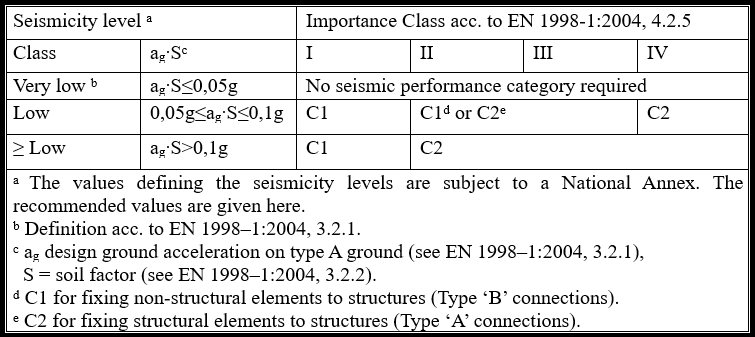
Buildings are classified in 4 importance classes, depending on the consequences of collapse for human life, on their importance for public safety and civil protection in the immediate post-earthquake period, and on the social and economic consequences of collapse.
- Class I – Buildings of minor importance for public safety, e.g. agricultural buildings, etc.
- Class II – Ordinary buildings, not belonging in the other categories.
- Class III – Buildings whose seismic resistance is of importance in view of the consequences associated with a collapse, e.g. schools, cultural institutions etc.
- Class IV – Buildings whose integrity during earthquakes is of vital importance for civil protection, e.g. hospitals, power plants, etc.
Fasteners used to resist seismic actions shall meet all applicable requirements for non-seismic applications. In the design of fastenings one of the following options a1, a2 or b shall be satisfied.
a) Design without requirements on the ductility of the fasteners. It shall be assumed that fasteners are non-dissipative elements and they are not able to dissipate energy by means of ductile hysteretic behaviour and that they do not contribute to the overall ductile behaviour of the structure.
- a1) Capacity design: The fastener or group of fasteners is designed for the maximum tension and/or shear load that can be transmitted to the fastening
- a2) Elastic design: The fastening is designed for the maximum load obtained from the design load combinations that include seismic actions EEd corresponding to the ultimate limit state (see EN 1998-1) assuming elastic behaviour of the fastening and the structure.
b) Design with requirements on the ductility of the fasteners.
Option b should not be used for the fastening of primary seismic members (see EN 1998-1) due to the possible large non-recoverable displacements of the fastener that may be expected. Unless shear loads acting on the fastening are resisted by additional means, additional fasteners should be provided and designed in accordance with option a1 or a2.
In order to test the bond strength of rebar under seismic loads, two series of tests are conducted. They are performed with post-installed rebars for the minimum (series 1) and the maximum (series 2) concrete strength for which assessment is sought. The test is designed on the assumption of general comparability to bond properties of cast-in rebar.
The tests shall be performed in displacement control using the required constant slip protocol. The protocol consists in the application of ten displacement cycles between +su (pull-out) and –su (push-in) followed by a residual load test. The value of su needed to perform the cyclic tests shall be taken in accordance with Table 2.
Table 2 Limiting displacement su

The displacements should be measured at the unloaded end of the rebar as shown, for example, in Figure 2.1. and they shell be measured in a consistent manner.
During the test, the tension load (or bond stress) and the displacement relative to a fixed point outside of the concrete of the test specimen shall be continuously recorded and plotted.
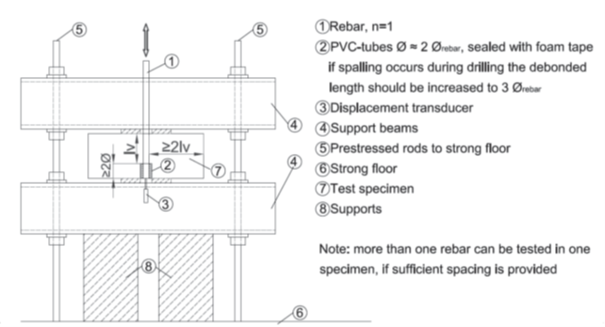
Figure 1 Example of pull-out test setup with displacement measurements at the unloaded
Source: “EAD 331522-00-0601”
The EasyFix program allows seismic loads to be taken into account in fastener design cases, both in the Concrete and Rebar modules. In the Concrete module adapted for operation under seismic actions are bonded anchors: R-KEXII with seismic resistance C1 and C2, R-KERII with seismic resistance C1, and throughbolt anchor R-HPTII-ZF/A4 with seismic resistance C1 and C2. For the Rebar module, calculations can be made using R-KEXII epoxy resin.
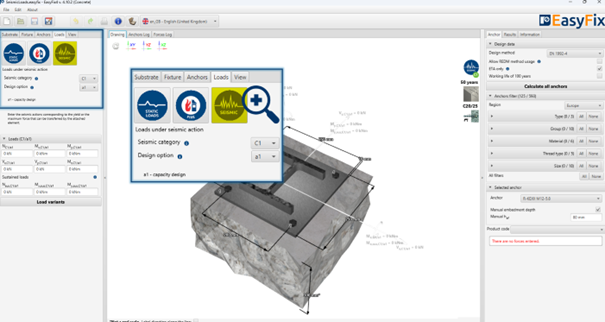
If you have any additional questions, please contact us – Rawlplug Technical Helpdesk
Download and check the program EasyFix
Find out more at rawlplug.com

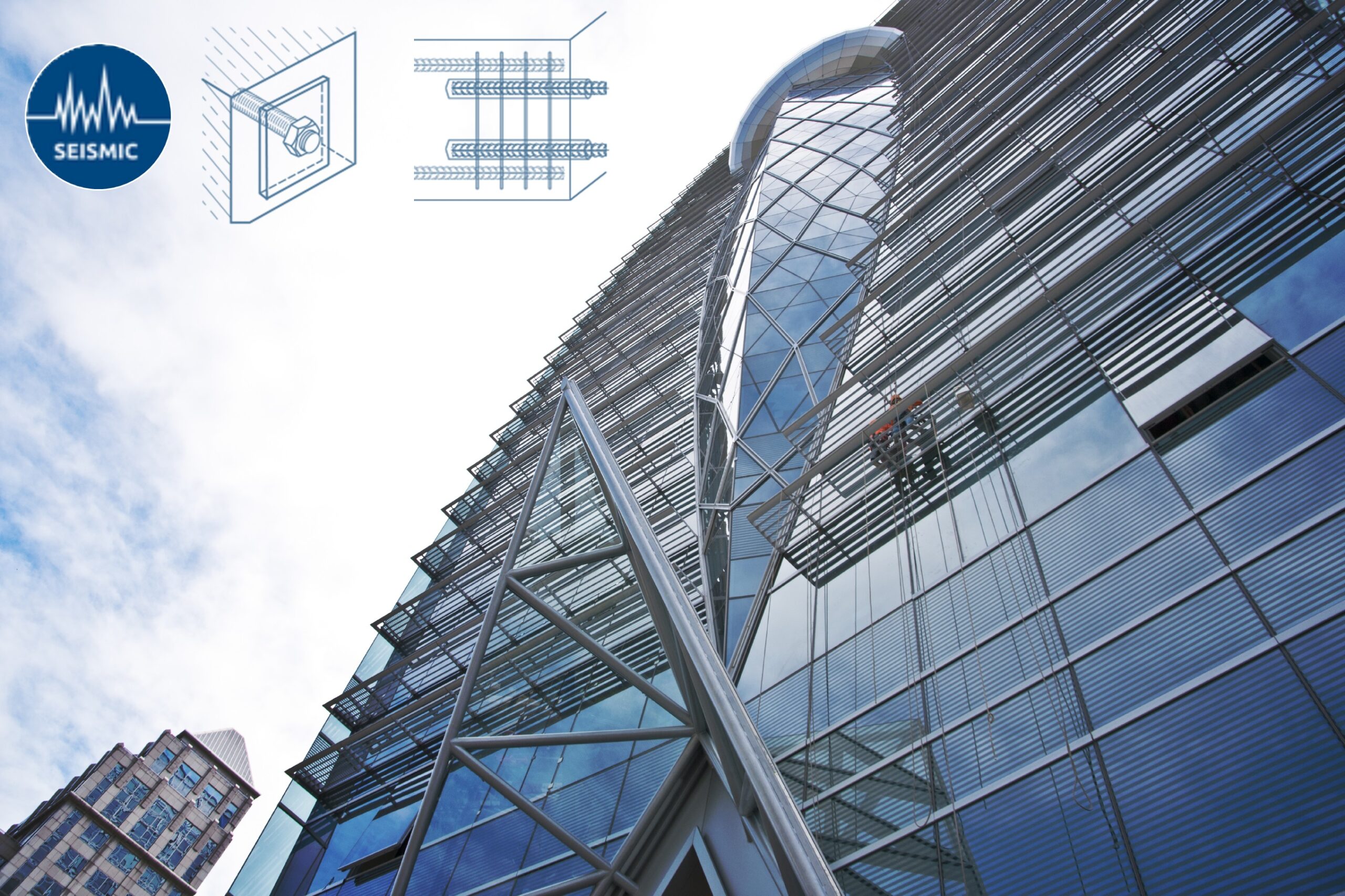
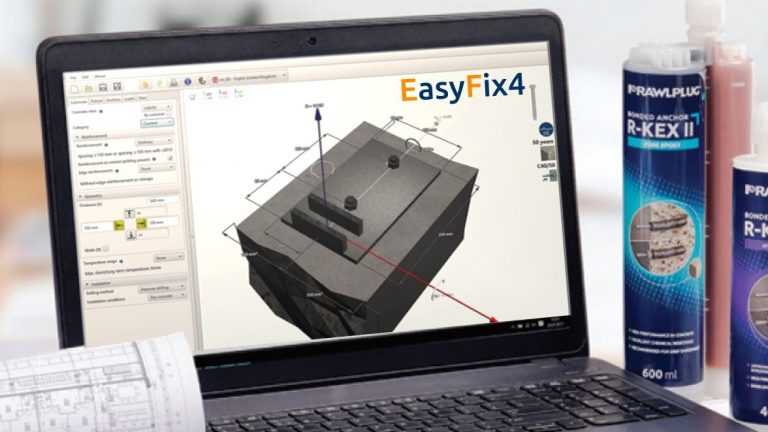





Comment section
Share this article: